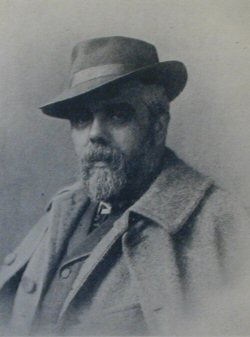
TOM McEWAN
THE son of a foreman pattern-designer in Inglis & Wakefield's
calico-printing works at Busby, Mr. McEwan was born in that industrious village
on the Cart, and among its homely cottage interiors and rural surroundings
acquired the early impressions which he was afterwards to invest with the poetic
glamour of art and song. Among his father's friends was James Docharty, also a
pattern-designer, who became the well-known landscape painter, and it was
probably his dreams and ambitions, expounded when he visited the McEwans'
cottage, which first opened the boy's eyes to the wonder and charm of the world.
In 1859 the little household removed to Glasgow, and the lad entered upon a
seven years' apprenticeship as a designer in the works of Todd & Higginbotham.
Here he pored over the treasures of the Stirling's Library, revelling especially
in the ancient Scots ballads, and at the first exhibition of the Glasgow
Institute of Fine arts, in 1861, he found the suggestion which guided him to his
real career. Two years later he saved enough money to attend Mr. Greenlees'
classes at the School of Art, where he gained several medals and a national
medallion for design. His leisure was spent in out-door sketching, and in 1867,
during his first real holiday, a summer week in Arran, he came under the charm
of that old-world cottage life which has since furnished the main subjects for
his brush. Four years later he struck the keynote of his work with a picture
painted at Corrie, "Comfort in Arran," which was hung in the Glasgow Institute.
In 1872 he spent a month in a sketching tour with James Docharty through Islay
and Jura, and six months later he cast the die, gave up his situation as a
designer, and adopted the painter's profession. He was then twenty-six years of
age, and for fourteen years he had been preparing for the step. Subsequent
events have justified his decision. From the first he had a vein and a public of
his own, and no one in Glasgow has a more assured reputation to-day. He early
exhibited at the Royal Scottish Academy, and in 1887 had his first picture hung
at Burlington House; but he has not sought recognition by sending his pictures
far afield. Nor does he paint very many pictures, but no artist has done more to
portray the heart and pathos of the humble Scottish home. Among his best-known
pictures are "Tired Out," an old granny with a child; "The Herd's Dinner;" "A
Lesson in Thrift," a young mother and child gathering wood; and "Amaist her only
Pleasure," an old woman reading her Bible. The late Robert Walker wrote of the
artist:- "His pictures are the unaffected outcome of their author's honest
feeling and true sympathy, begotten of his intimate knowledge of the class of
people he depicts. In his own way he is as national as Burns."
Mr. McEwan has been President of Glasgow Art Club in 1876, 1893, and 1894. He is
a member of the Royal Scottish Society of Painters in Water Colours, to whose
exhibitions he is a faithful contributor, and he has acted on the Council of the Glasgow
Institute of the Fine Arts. He is also a member of Glasgow Ballad Club, and
poems from his pen, of homely subjects, like his pictures, have been printed in
the Club's volumes and in Good Words and other periodicals.
Back to
Index of Glasgow Men (1909)